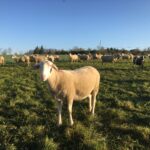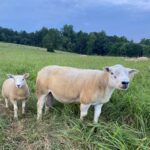Introduction to Sheep Breeds
Where does your sheep breed come from originally?
There are many different sheep breeds worldwide. Their many different looks, sizes and production records were shaped by their purpose and by the environment in which they were bred and raised. In this article I attempt an introduction to the history of sheep breeds.
Wool Sheep
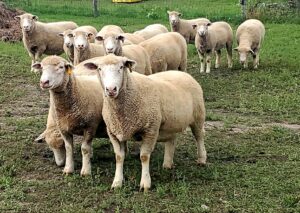
Dorset sheep are considered to be a dual-purpose breed, raised for both meat and wool. Courtesy of JoJo Walker
Sheep producing wool is probably what most people in Western civilizations associate with sheep. When human civilization formed, sheep were selected and bred that had lost its natural ability to shed, to lose the hair when spring came. That wool was sheared and spun into fiber. In fact, sheep wool was for many centuries a material from which a lot of clothing was made from. Over the years it lost market shares to other natural fibers, most notably to cotton. In more modern times it lost out even more significantly to synthetic fibers. Another very widespread use for wool were uniforms. The advantage of wool for military uniforms was that wool does not burn, it only melts under a fire’s heat. Nowadays, the use of wool for any military garment is also very limited.
The loss of use for wool caused wool markets to collapse. Since wool sheep still need to be sheared once a year, shearing sheep has in many cases become a cost rather than a source of income. Aside from the cost, shearers are harder and harder to find. Fewer and fewer people wish to do this hard-breaking job. I am one of them.
There are two notable exceptions to the collapse of the price of wool. The first one is the market for very fine wool. Such fine wool is used for luxury clothing (such as high-end suits), high-performance sportswear and next to skin clothing. Such fine wool has a soft touch to the skin, coarser wool makes your skin itch. Such very fine wool is called superfine wool, measuring below 17 microns (a micron is .00003937 inches in diameter). The only sheep breed worldwide producing such wool are Merino sheep. Merinos originated in Spain. Sheep of this breed were so valuable for hundreds of years that until the year 1765 it carried a death sentence when people attempted to export Merino sheep to other countries. Nowadays Australia is THE leading producers of superfine Merino wool. Such wool can only be produced in arid climates, which makes Australia the ideal place. In humid climates such fine wool would not dry out on the body of the sheep carrying it and literally rot. Therefore, the wool of Merino sheep raised in climates that are less ideal is not as fine.
The second exception to the collapse of wool prices is the increase in popularity of hand spinning and knitting. While it is a relatively small market for such wool, it has allowed producers of long-stapled coarse wool to establish a niche market, often also including naturally colored (instead of white) wool. Romney, Bluefaced Leicester, Shetland, and Icelandic sheep are some of the breeds that benefited from that market.
Milk Sheep
There are very few breeds of milk sheep that produce enough milk to be able to enter the commercial market. The most widespread and the most known dairy breed of sheep are East Friesian sheep. Lacaune, known for its hardiness, and Awassi sheep are also known dairy breeds. There are many other regional sheep breeds with less production and with names we rarely or never hear that are milked by the local population. The sheep milk is most often used to make cheese and is not much used to drink. Known cheeses that are originally sheep cheeses are cheeses like Feta, Romano, and Roquefort.
Meat Sheep
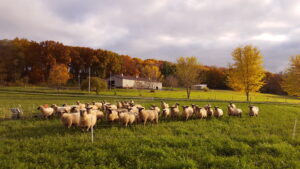
Shropshire sheep are a meat breed, often used in maintaining Christmas tree plantations as they are said to not eat conifers.
Cody Hiemke / Mapleton Mynd Shropshires, LLC
The pool of sheep breeds used to produce meat is large. Most sheep breeds meant to produce meat have one thing in common: they originated one way or another on the British Isles. In fact, the British meat sheep breeds were so successful, that many other countries used them to create their own meat sheep breeds or to improve local and regional sheep breeds. Originally, most meat breeds were dual purpose sheep that produced both meat and wool. That means, most of the well-known meat sheep also produce wool, albeit a far coarser wool than Merino wool.
There are many known meat sheep breeds that can be found in the US. Here are some of their names: Hampshire, Southdown, Suffolk, Shropshire, Cheviot, Dorset, Horned and Polled alike (the latter are until this day two wonderful dual-purpose breeds). A well-known meat sheep breed that did not originate in Britain is the Texel sheep, a breed from the Netherlands. Yet, Texel sheep were also improved using British breeds of sheep. The same holds true for the best-known French meat breeds, Charollais and Île-de-France sheep.
Hair Sheep
Hair sheep breeds are both ancient and modern. They are mostly raised for meat, which is known for its mild flavor. All of them have in common that they produce hair or even wool that the sheep shed and thus don’t need to be sheared. The ancestors of most hair sheep that exist still today in barren landscapes with sparse grazing and little precipitation like in mountainous terrain in the Middle East and Northern Africa pre-date wool breeds. On the other hand, more modern hair sheep breeds were developed or gained more popularity in recent decades because of the seemingly permanent decline of wool prices. Katahdin sheep is one of these breeds and are the most widespread hair sheep in the US. They were developed by a Maine sheep breeder, using meat sheep like Suffolk and a shedding sheep breed from the Virgin Islands named St. Croix. He then named the new breed after Mount Katahdin.
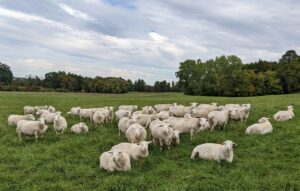
White Dorper sheep are one of the meatiest breeds among the hair sheep breeds.
Ulf Kintzel / White Clover Sheep Farm
Dorper sheep are the other sheep breed that is common in the US. Dorper sheep are less numerous, but the breed produces substantially more meat than most other common hair sheep breeds, especially larger prime cuts (loin and rib chops as well as leg-of-lamb). White Dorper sheep are a variation of Dorper sheep. Both breeds were developed using Horned Dorset Sheep but while the shedding Persian Blackhead played a large role in developing Dorper sheep, the purely white Van Rooy sheep also played a role in the creation of White Dorper sheep. These gentle Van Rooy sheep are said to account for the calmer disposition and better shedding ability of White Dorpers compared to Dorpers.


